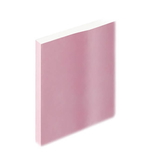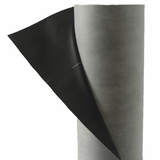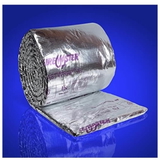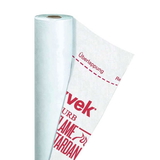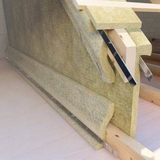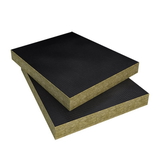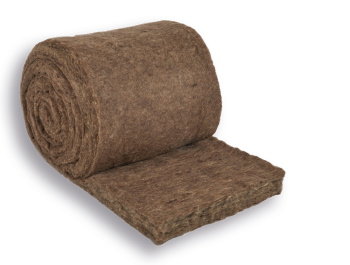- Blogs
- Types of Fire Rated Insulation
Types of Fire Rated Insulation

Any type of insulation used in a building is required to meet the building regulations. These are set norms, frequently updated, by the British government to help you build energy-efficient homes. Homes, that are not only thermally efficient but also give adequate fire safety.
In the face of potential fire hazards, the right insulation can provide valuable protection, reducing the spread of flames and delaying the passage of heat. With advancements in technology and increased awareness about fire safety regulations, there is a range of fire-rated insulation options to choose from.
Whether you're a homeowner, contractor, or simply an individual curious about fire safety, this blog aims to equip you with valuable knowledge about different types of fire-rated insulation commonly used in the United Kingdom.
Why is Fire-rated Insulation Important? ![]()
Fire-rated insulation plays a critical role in ensuring the safety and protection of buildings, making it an essential consideration for homeowners, contractors, and architects alike. Here are several reasons why fire-rated insulation is of utmost importance:
-
Fire Safety: The primary purpose of fire-rated insulation is to limit the spread of fire within a building. By impeding the progress of flames and the transfer of heat, it provides valuable time for occupants to evacuate safely and for emergency responders to intervene. It helps compartmentalise fire, preventing it from rapidly spreading to other areas of the building.
-
Compliance with Building Regulations: Building regulations stipulate specific requirements for fire safety in construction. Fire-rated insulation is often a mandatory component to meet these regulations, ensuring that buildings are designed and constructed with adequate fire protection measures in place. Compliance with these standards is necessary to obtain the necessary permits and certifications.
-
Structural Integrity: Fire-rated insulation helps preserve the structural integrity of a building during a fire. It slows down the rate at which structural components, such as steel beams or wooden frames, lose their strength due to heat exposure. By maintaining the integrity of the building's structure, fire-rated insulation contributes to reducing the risk of collapse and assists firefighters in their efforts to combat the fire.
-
Smoke Control: Alongside fire, smoke is a significant hazard during a fire incident. Fire-rated insulation can help impede the spread of smoke through walls, floors, and ceilings. By restricting the movement of smoke, it enhances the visibility and breathing conditions for occupants, allowing them to navigate the building more safely.
-
Energy Efficiency: Fire-rated insulation not only provides fire protection but also offers thermal insulation properties. It helps regulate temperature by minimising heat loss or gain, resulting in energy savings and improved energy efficiency for the building. This dual functionality enhances the overall sustainability of the structure.
- Peace of Mind: Ultimately, fire-rated insulation provides peace of mind for homeowners and occupants. Knowing that their homes or buildings have an extra layer of protection against the devastating effects of fire can alleviate concerns and create a safer living environment. It instils confidence in the fire resistance of the structure and contributes to a sense of security for all occupants.
Fire Rated Insulation
Fire Ratings of Insulation
In the United Kingdom, fire assessments for insulation materials are primarily governed by the following key standards:
-
BS 476: Part 6 and Part 7: These British Standards define the fire performance of building materials, including insulation.
-
BS 476: Part 6: This standard determines the fire propagation index of the material through the measurement of flame spread on the surface.
-
BS 476: Part 7: This standard determines the classification of the material based on its ability to withstand the spread of fire in vertical installations.
-
- BS EN 13501: This European standard establishes the classification system for the reaction to fire of construction products, including insulation materials. It categorises materials based on their performance in relation to fire propagation, smoke production, and the release of flaming droplets or particles.
-
Approved Document B (ADB): This document provides guidance on fire safety regulations for buildings in England. It sets out the minimum standards and requirements for fire performance, including insulation materials, in different types of buildings and structures.
-
Local Building Regulations: Each UK country (England, Scotland, Wales, and Northern Ireland) has its own set of building regulations that may have specific requirements for fire safety and insulation materials. These regulations may reference the standards mentioned above or provide additional guidance specific to the region.
The outcomes of these tests are utilised by contractors to identify the most suitable insulation that possesses fire-resistant properties for their requirements/projects.
Additionally, third-party certification schemes, such as the Loss Prevention Certification Board (LPCB) and British Board of Agrément (BBA), provide independent assessments and certifications for the fire performance of insulation materials. These certifications offer further reassurance of the tested and verified fire resistance of the insulation products.
When selecting insulation materials, it is recommended to choose products that meet the required fire performance standards and carry appropriate certifications. Consulting with building professionals, architects, and fire safety experts can provide valuable guidance in ensuring compliance and selecting the right fire-rated insulation for specific applications.
Classification of Insulation Materials based on BS EN 13501
Under BS EN 13501, the European standard for the classification (Euroclass) of the reaction to fire of construction products, there are several classifications that indicate the fire performance of materials. These classifications include:
| Class | Description | Examples of Insulation Materials |
|---|---|---|
| A1 | Non-combustible materials with no contribution to fire, no flaming droplets/particles | Mineral Wool, Glass Wool |
| A2 | Limited combustibility, very limited contribution to fire, no significant smoke emission or droplets/particles | Phenolic Foam Insulation, Some Rock and Fibreglass Products |
| B | Limited contribution to fire spread, low fire growth rate, limited smoke production | PIR (Polyisocyanurate) Foam, Some Rigid Phenolic Foam Products |
| C | Moderate contribution to fire spread, moderate fire growth rate, moderate smoke production | EPS (Expanded Polystyrene) Foam, Some Flexible Foams |
| D | High contribution to fire spread, high fire growth rate, significant smoke production | XPS (Extruded Polystyrene) Foam, Polyurethane Foam |
| E | Very high contribution to fire spread, very high fire growth rate, substantial smoke production | Some Flexible Foams, Phenolic Foam (lower density grades) |
| F | No performance determined or does not meet the criteria of the lower classes (unclassified or does not meet minimum requirements) | Some Fibrous Insulation Products, Insulating Foams |
Insulating materials with higher classifications (such as A1 or A2) are generally considered to have better fire performance and are often preferred for applications where higher fire resistance is required.
Note: The explanations in the table above are just a simplification of the prevailing national and European Standards, to help improve understanding of fire-resistant insulation. Chase Insulations Ltd assumes no liability for the correctness of the details or any misinterpretation they may cause.
Please note that the examples provided are not an exhaustive list, and there may be other insulation materials available for each fire rating classification. It's important to consult manufacturers and experts in the field to ensure that the specific insulation material chosen meets the required fire rating and is suitable for the intended application.
What are Class 0 and Class 1 ratings?
Class 0 and Class 1 are additional fire ratings commonly used in the UK, although they are not specifically defined under BS EN 13501. These ratings are often associated with the surface spread of flame and are typically used in building regulations and specifications.
Here's an overview of Class 0 and Class 1 ratings:
-
Class 0: This rating refers to a surface with the highest level of fire performance in terms of spread of flame. The Class 0 rating is defined in Approved Document B of the Building Regulations 1991, which combines two tests from the British Standard BS 476.
It indicates that the material has achieved the criteria set out in national standards, including: 
- Limited flame spread: The material must not allow the flame to spread across its surface.
- Low heat release: The material should have low heat release characteristics during combustion.
- Limited smoke production: The material should produce minimal smoke during combustion.
Class 0 is often required for materials used in specific areas such as escape routes, high-rise buildings, and buildings with strict fire safety regulations.
-
Class 1: This rating indicates a surface with moderate fire performance in terms of spread of flame. It signifies that the material has undergone fire testing and has met the criteria set out in national standards, which include:
- Limited flame spread: The material must have a limited ability to allow the flame to spread across its surface.
- Moderate heat release: The material should have moderate heat release characteristics during combustion.
- Moderate smoke production: The material should produce an acceptable level of smoke during combustion.
Class 1 is commonly required for materials used in general building applications, where a lower level of fire resistance is acceptable based on the specific context and regulations.
Class 0 and Class 1 rating primarily focus on the surface spread of flame and are often used as specifications for wall and ceiling linings, claddings, and similar materials. When it comes to overall fire performance and insulation properties, standards mentioned earlier (e.g., BS EN 13501), should be considered alongside Class 0 and Class 1 ratings.
In the UK, HVAC (Heating, Ventilation, and Air Conditioning) insulation materials are typically classified based on this method. Insulation products like Kingspan Kooltherm, Isover Climpipe, ductwrap and Armaflex pipe Insulation have the highest Class O fire ratings making them ideal for use across projects.
It's important to note that HVAC insulation materials may have additional fire performance classifications beyond Class 0 and Class 1. These can include more specific ratings related to factors such as smoke production, flaming droplets/particles, or fire propagation.
Non-combustible Insulation
Non-combustible materials are generally considered to offer the highest level of fire resistance and are often preferred in applications where fire safety is of utmost importance. Some of the most commonly used non-combustible insulating materials include rock mineral wool, fibreglass insulation and Cellular glass insulation.
Here, at Buy Insulation Online, we stock and supply a wide range of non-combustible insulation with A1 or A2 ratings (as indicated by the manufacturer documents). Examples for A1 rated non-combustible insulation include Knauf Rocksilk including RS45 and RS60, Rockwool RWA45, Mineral wool rolls like Knauf Loft roll, Rockwool Ductwrap, Boards including Rockwool Fire-barrier and fibre cement boards. Example for A2 rated insulation includes Isover ductwrap and some other glass or rock wool insulation
How do Some common Insulating Materials react to fire?
Fibreglass Insulation: ![]()
As mentioned above, fibreglass has a Euroclass A1 or A2 rating, which puts the product under the non-combustible or limited combustibility category. Fibreglass insulation has a high melting point, typically around 1,200 to 1,500 degrees Celsius (2,192 to 2,732 degrees Fahrenheit). This high melting point allows the material to maintain its structural integrity for a significant amount of time during a fire.
In addition, Fiberglass insulation acts as a thermal barrier, slowing down the transfer of heat and also produce limited smoke when exposed to fire. Fibreglass insulation products are often tested and certified for their fire performance. They are manufactured to meet relevant building codes and standards, such as those related to fire spread, flame propagation, and smoke production.
Mineral wool Insulation:
Rock mineral wool insulation exhibits excellent fire resistance properties. It is non-combustible, has a high melting point, acts as a fire barrier, produces minimal smoke, and provides effective heat insulation. Rock mineral wool insulation helps to prevent the spread of flames, maintain structural integrity, limit smoke generation, and reduce heat transfer during a fire.
Sheep Wool Insulation:![]()
Sheep wool insulation is a natural fibre insulation material. It is generally considered to be relatively safe in terms of fire performance. Sheep wool is naturally flame retardant due to its high moisture content and the presence of keratin, which is less prone to igniting compared to other materials.
However, the fire performance of sheep wool insulation can vary depending on the specific product and treatment. Some sheep wool insulation products are treated with fire-retardant chemicals to enhance their fire resistance properties.
Wood Fiber Insulation:
Wood fibre insulation is made from processed wood fibres or recycled wood waste. Wood fibre insulation can offer good fire performance due to the inherent properties of wood. Wood contains cellulose, which is a combustible material. However, wood fibre insulation products are typically treated with fire retardants to improve their fire resistance. These treatments can significantly enhance their ability to resist flame spread and limit smoke production.
Hemp Insulation:
Hemp insulation is derived from the fibres of the hemp plant. Similar to wood fibre insulation, hemp insulation contains cellulose and may be combustible to some extent. However, hemp insulation products are often treated with fire retardants to improve their fire resistance. These treatments aim to reduce flame spread and enhance the material's ability to resist ignition and heat transfer.
Multifoil Insulation: ![]()
Multifoil insulation is a type of reflective insulation that typically consists of multiple layers of foil and air spaces. In general, foil insulation products are not considered to be fire-resistant, as thier fire rating may not be as high as that of mineral wool insulation.
Some multifoil insulation products are designed with fire retardant additives or treatments to enhance their fire resistance. These additives aim to reduce flame spread, limit smoke production, and improve the overall fire performance of the insulation.
Foam Insulation:
PIR Foam Insulation: Polyisocyanurate (PIR) foam insulation is not fire-resistant. PIR works by trapping air, which does not help with fire safety. PIR foam insulation boards can achieve various fire ratings, such as Class 0 or Class 1, which indicate their performance in terms of flame spread, smoke production, and fire resistance. The fire safety of PIR can be improved using additives while manufacturing.
Polystyrene Foam: Polystyrene foam insulation, in its standard form, is typically not considered fire-rated. Polystyrene foam insulation, both EPS and XPS, are combustible and can ignite when exposed to flames or high temperatures. It is derived from a petroleum-based material and contains flammable components.
However, certain manufacturers may offer fire-rated versions of polystyrene foam insulation that have undergone specific testing and meet certain fire performance standards
Phenolic Foam Insulation: Phenolic foam insulation is known for its excellent fire resistance. It is inherently non-combustible and does not contribute to flame spread. Phenolic foam insulation is made from a thermosetting plastic material that is chemically resistant to burning.
Frequently Asked Questions
Is there fireproof insulation?
No insulation material can be considered completely fireproof. All insulation materials have varying degrees of fire resistance, but they can still be susceptible to damage or combustion under extreme heat and prolonged exposure to fire. The term "fireproof" implies that the material is impervious to fire, which is not the case with insulation materials.
What is Fire resistant Insulation?
Fire-resistant insulation refers to insulation materials that have been specifically designed and manufactured to exhibit enhanced fire resistance properties. These materials are engineered to resist the spread of flames, reduce smoke production, and maintain their structural integrity under high temperatures, thereby providing an additional level of protection in the event of a fire. Some common examples of fire resistant insulation are those with A1 and A2 Euroclass ratings including fibreglass, mineral wool etc.
In conclusion:
fire-rated insulation plays a crucial role in enhancing the fire safety of buildings. The fire performance of insulation materials is an important consideration to prevent the spread of flames, limit smoke production, and protect occupants and property in the event of a fire.
When selecting fire-rated insulation, it is essential to consult with manufacturers, review technical specifications, and adhere to local building regulations. Fire safety experts and professionals can provide valuable guidance to ensure the chosen insulation materials meet the required fire ratings and are suitable for the specific application.
By prioritising fire rated insulation and implementing appropriate fire safety measures, we can significantly improve the overall fire resistance and safety of buildings. Ensuring effective fire protection not only safeguards lives but also helps minimise property damage, providing peace of mind for occupants and building owners alike.
For non-combustible fire insulation like mineral wool insulation slabs, insulation rolls and fire-rated boards visit Buy Insulation Online. Our experts are just a call away, should you need any assistance while buying fire-rated insulation online.
Disclaimer:
Fire safety is a serious topic. The content of this article is general information and does not constitute any sort of professional advice. Please seek fire safety consultants if you are looking for actual advice on fire-rated insulation.

Samuel Hitch
Managing Director
Buy Insulation Online.
Leave A Reply
Your feedback is greatly appreciated, please comment on our content below. Your email address will not be published. Required fields are marked *













